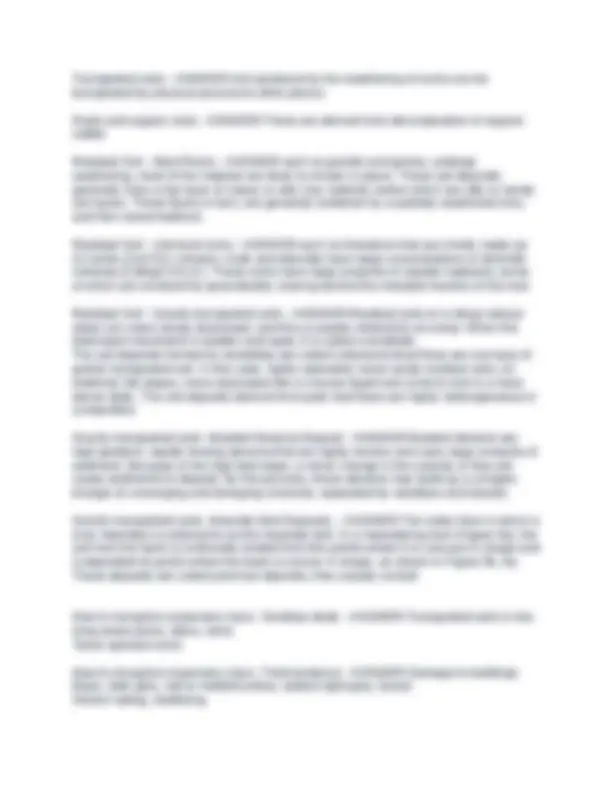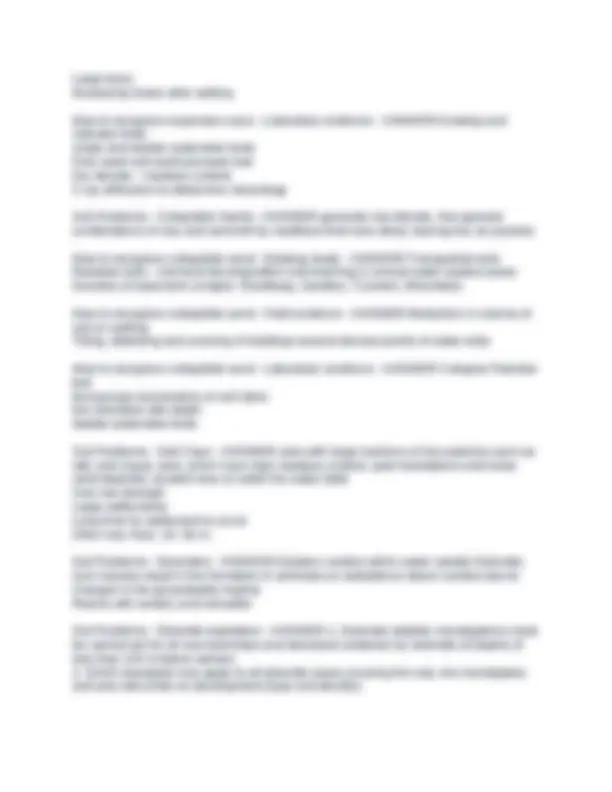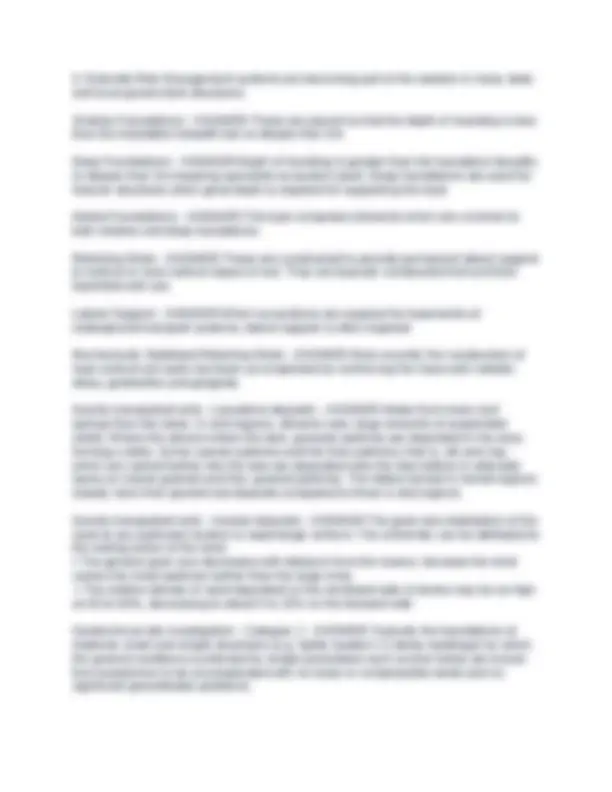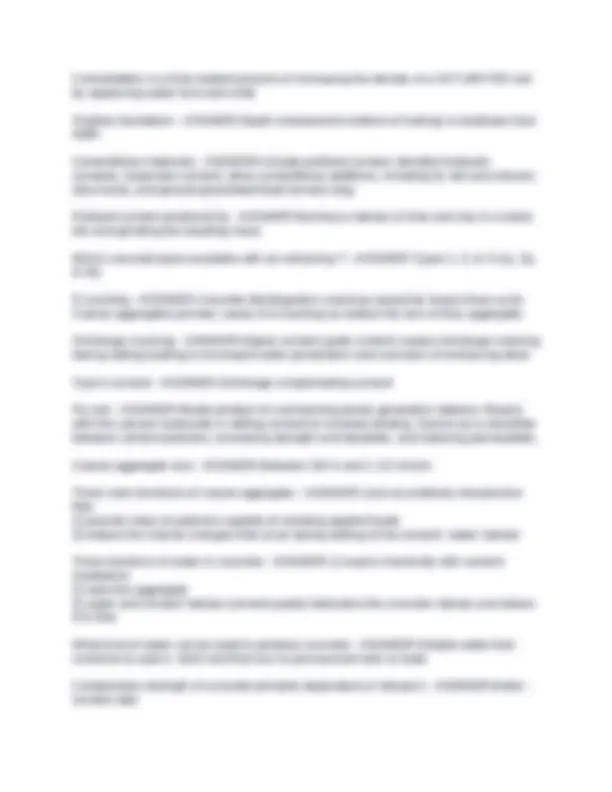







Study with the several resources on Docsity

Earn points by helping other students or get them with a premium plan


Prepare for your exams
Study with the several resources on Docsity

Earn points to download
Earn points by helping other students or get them with a premium plan
Community
Ask the community for help and clear up your study doubts
Discover the best universities in your country according to Docsity users
Free resources
Download our free guides on studying techniques, anxiety management strategies, and thesis advice from Docsity tutors
PE Civil Exam – Geotechnical with Complete Solutions
Typology: Exams
1 / 9

This page cannot be seen from the preview
Don't miss anything!






Void Ratio, e - ANSWER-or Vv/Vs Porosity, n - ANSWER-or Vv/Vt Saturation, S - ANSWER-or Vw/Vv Dry unit weight (Ɣd) - ANSWER- Wet unit weight (Ɣw) - ANSWER- Specific Gravity (Gs) - ANSWER- dry density (ρd) - ANSWER-Ws/Vt OR ρ / (1+w) Water content, w - ANSWER-Ww/Ws Truss - ANSWER-A truss is an assemblage of straight members connected at their ends by flexible connections (pin-jointed) to form a rigid configuration. Use of Truss - ANSWER-Trusses are widely used for applications such as supporting bridge decks, roofs of buildings, floor slabs, electricity pylons, towers, domes etc. Simple Truss (2D) - ANSWER-2D plain trusses e.g. bicycle frame Planar truss - ANSWER-Consist of joining plane trusses Space Frame Truss - ANSWER-3D framework Pitched Truss - ANSWER-A truss having inclined top chords. Flat truss - ANSWER- Truss Members - ANSWER- Types of connections in timber trusses - ANSWER-Metal plate and bolts
Nail plate Traditional method using Hardwood pegs Types of connections in steel trusses - ANSWER-Bolts and nuts (also rivets, but they are now rarely used) Welded joint Plane truss determinacy calculations - ANSWER-m = 2j - r m = number of members in the truss j = number of joints in the truss r = number of external reactions Assumptions for analysis of Trusses - ANSWER-i. All members are connected only at their ends by frictionless hinges ii. All loads and support reactions are applied only at the joints iii. The centroidal axis of each member coincides with the line connecting the centers of the adjacent joints iv. The dead weight of the truss members is distributed along its length; hence it is ignored Characteristics of engineering soils - ANSWER-Gravel (2mm - 75mm) Sand (0.05mm - 2mm) Silt (0.002mm - 0.05mm) Clay (< 0.002mm) boulders (> 256 mm) cobbles (64 mm - 256 mm) pebbles (4 mm - 64 mm) granules (4 mm - 2 mm) Mechanical Weathering - ANSWER-The process by which rocks are broken into smaller pieces by physical forces e.g. running water, wind, ocean waves, glacier ice, frost, and expansion and contraction caused by the gain and loss of heat. Chemical Weathering - ANSWER-The process of chemical decomposition of the original/parent rock. In the case of mechanical weathering, the rock breaks down into smaller pieces without a change in its chemical composition. However, in chemical weathering, the original material may be changed into something entirely different. Residual soils - ANSWER-These soils stay where they were formed and cover the rock surface from which they were derived The rate of weathering is higher in warm and humid regions compared to cooler and drier regions and, depending on the climatic conditions, the effect of weathering may vary widely Common in the tropics. The nature of a residual soil deposits will generally depend on the parent rock.
Large trees Measuring heave after wetting How to recognize expansive clays - Laboratory evidence - ANSWER-Grading and indicator tests single and double oedometer tests Free swell and swell pressure test Dry density - moisture content X ray diffraction to determine mineralogy Soil Problems - Collapsible Sands - ANSWER-generally low-density, fine-grained combinations of clay and sand left by mudflows that have dried, leaving tiny air pockets. How to recognize collapsible sand - Desktop study - ANSWER-Transported soils Residual soils - chemical decomposition and leaching in annual water surplus areas Granites of basement complex: Randburg, Sandton, Tzaneen, Mbombela How to recognize collapsible sand - Field evidence - ANSWER-Reduction in volume of soil on wetting Tilting, distorting and cracking of buildings around obvious points of water entry How to recognize collapsible sand - Laboratory evidence - ANSWER-Collapse Potential test Microscope examination of soil fabric Dry Densities with depth double oedometer tests Soil Problems - Soft Clays - ANSWER-soils with large fractions of fine particles such as silty and clayey soils, which have high moisture content, peat foundations and loose sand deposits, located near or under the water table Very low strength Large settlements Long time for settlement to occur Often very thick: 20 -50 m Soil Problems - Dolomites - ANSWER-Solution cavities within water soluble Dolomite rock masses result in the formation of sinkholes or subsidence above cavities due to changes in the groundwater regime Reacts with weakly acid rainwater Soil Problems - Dolomite legislation - ANSWER-1. Dolomite stability investigations must be carried out for all new townships and structures underlain by dolomite at depths of less than 100 m below surface.
Soil: What is the soil (or ground) profile and groundwater regime? Structure: size of structure, structural form and layout, the type, magnitude and direction of the applied loads, allowable foundation movements.. Safety: Numerous ground-related hazards may affect the site. Sustainability. This requires consideration of environmental and social factors and the economic implications of different options. Two basic soil types - ANSWER- Cohesive Soils - ANSWER-the load is transferred to the soil and water particles that make it up. However as water cannot take shear stresses the water tends to want to flow away, however in cohesive soils due to the low permeability this cannot take place immediately. Granular Soils - ANSWER-the permeability is much higher, when it is loaded, hence, the pore water will tend to flow away. Consequently the pore water pressure does not increase above the hydrostatic pressure. Soil Problems - Expansive Clays - ANSWER-- Contains Clay minerals
Consolidation is a time related process of increasing the density of a SATURATED soil by squeezing water from soil voids Shallow foundation - ANSWER-Depth (measured to bottom of footing) is shallower than width Cementitious materials - ANSWER-Include portland cement, blended hydraulic cements, expansive cement, other cementitious additives, including fly ash pozzolanszl, silica fume, and ground granulated blast furnace slag Portland cement produced by - ANSWER-Burning a mixture of lime and clay in a rotary kiln and grinding the resulting mass Which concrete types available with air entraining? - ANSWER-Types 1, 2, & 3 (1a, 2a, & 3a) D cracking - ANSWER-Concrete disintegration cracking caused by freeze-thaw cycle. Coarse aggregates primary cause of d cracking so reduce the size of Max aggregate. Shrinkage cracking - ANSWER-Higher cement paste content causes shrinkage cracking during setting leading to increased water penetration and corrosion of reinforcing steel. Type k cement - ANSWER-Shrinkage compensating cement Fly ash - ANSWER-Waste product of coal burning power generation stations. Reacts with the calcium hydroxide in setting cement to increase binding. Serves as a microfiller between cement particles, increasing strength and durability, and reducing permeability. Coarse aggregate size - ANSWER-Between 3/8 in and 1 1/2 inches Three main functions of coarse aggregate - ANSWER-1)act as relatively inexpensive filler